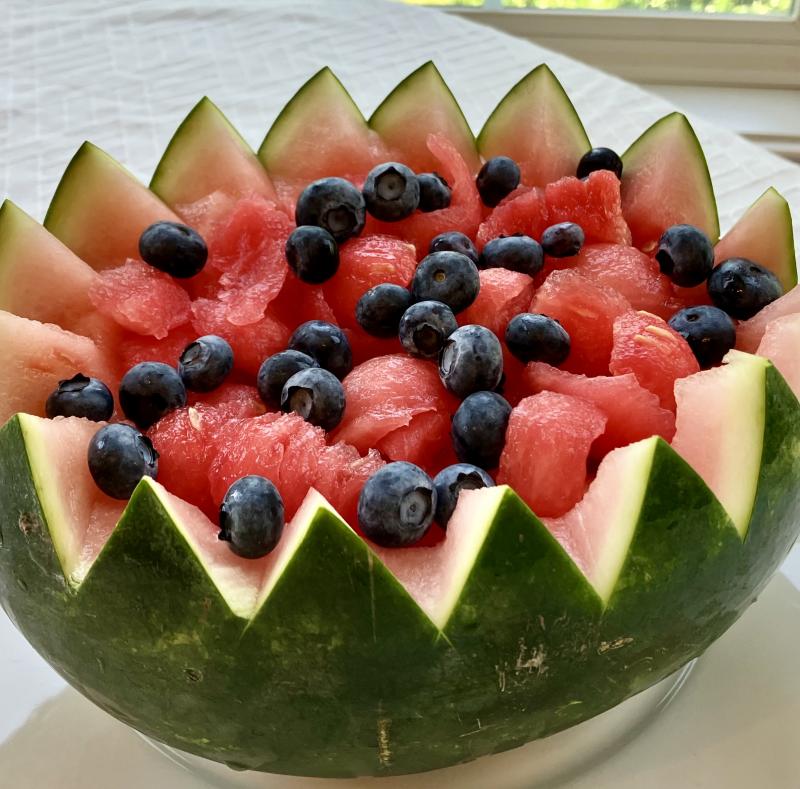Watermelons are a versatile, colorful summer treat
In this highly computerized age, we’ve come to realize that if we search the web for something like “melon baller,” the next time we log onto Facebook, we’ll have personalized pop-up ads for kitchen tools, including melon ballers. For those not familiar with the subject, this is a small, handheld tool with open metal hemispheres on each end. They will be two different sizes, and each round will have a hole in it to let the juice drain as you scoop out melon flesh.
The reason I needed one can be seen in the photo – a watermelon basket. And the watermelon in question is a type I hadn’t noticed before, a so-called personal watermelon. This varietal has been bred to weigh between four and six pounds, making it small enough to fit in your refrigerator, but still too large for just one individual serving. Beyond its size, a personal watermelon resembles its larger cousins in the species Citrullus lanatus. Inside the dark-green rind is the familiar juicy red flesh. Although the marketing sign claimed it was seedless, that’s only correct if you ignore the edible white seeds found inside.
Food historians believe watermelons originated in southern Africa. DNA analysis has confirmed that both wild and cultivated varieties of watermelon share a common ancestor in Namibia. Thousands of years ago, watermelon was cultivated in the Nile valley, and seeds were found in the tomb of King Tut. Chinese farmers were raising watermelons in the 10th century and they remain the world’s largest producer of the fruit.
By the 13th century, Europe was introduced to the watermelon, and a few hundred years later, the fruit found its way to the New World. A USDA horticulturist from Charleston, S.C., is credited with developing the hardy watermelon common today: oblong, sturdy, easy to ship and resistant to disease. A research team at the University of California developed the personal watermelon in the early 21st century, and it’s now cultivated in Arizona, New Mexico and Mexico.
Today, there are more than 1,200 varieties of watermelon, ranging widely in size and shape. The flesh of the fruit comes in several colors: red, orange, yellow and white. One of the most unlikely watermelon features has been exploited by the Japanese, who grow the fruit in glass boxes, forcing it into the shape of the square container. These Japanese novelty melons are harvested before reaching peak ripeness, so they may be better suited for pickles than dessert dishes.
The watermelon available now is not likely from local growers, as peak season is typically late summer. The sandy-loam soils of Southern Delaware make this region ideal for growing the popular summer staple. Whether local or trucked in from the west, watermelon can be stored uncut at room temperature for up to two weeks; once cut, they should be stored in a sealed container under refrigeration for up to a week.
I've included instructions on how to cut a basic melon basket. Some of the examples on the internet were more daunting; I wasn’t keen on trying to carve a handle. I tossed blueberries with the watermelon balls, but feel free to add blackberries, cantaloupe or pineapple, if you have them on hand. Any of these recipes would make a nice addition to your Fourth of July cookout.
Watermelon Cooler
1 personal watermelon
1/2 C vodka
1/4 C Triple Sec
3 T lime juice
Cut the melon flesh into chunks, discarding seeds and rind; reserve a few thin slices for garnish. Add the fruit to the bowl of a blender or food processor and purée. Place a fine sieve over a pitcher and pour in the watermelon purée. You should collect about 2 1/2 C juice; discard the solids. Stir in vodka, Triple Sec and lime juice. Pour cocktails into ice-cube-filled glasses and garnish with a watermelon slice. Yield: 6 servings.
Composed Fruit Salad
1/2 personal watermelon
2 peaches
2 nectarines
4 slices red onion
2 T chopped parsley
1/2 C crumbled feta cheese
salt & pepper, to taste
1 T olive oil
Cut watermelon into one-half-inch slices and use a cookie cutter to create circles (or other shapes) of fruit. Arrange in a single layer on a serving platter. Cut the peaches into eighths and scatter over the watermelon. Peel the nectarines and separate the sections; add to the platter. Slice the onion very thinly and add to the platter. Sprinkle on the parsley and feta cheese. Add salt and pepper to taste. Drizzle with olive oil and serve. Yield: 4 servings.
Watermelon Basket
1 personal watermelon
1/2 pt blueberries
1/2 pt blackberries
juice and rind of 1 lemon
Cut a very thin slice of rind from one of the long sides to create a flat base; do not cut into the flesh. Sit the melon on its cut side and cut off the rind about 1 to 2 inches from the top. Rotating the melon will help you keep the cutting line even. Empty the center of the melon with the melon-baller, staging the balls in a bowl. When the rind is empty, begin cutting at an angle from the top edge of the melon rind to create a wedge-shaped border. Add blueberries, blackberries, lemon rind and juice to the melon balls and toss to combine. Fill the melon basket with fruit. Chill before serving. Yield: 6 servings.























































